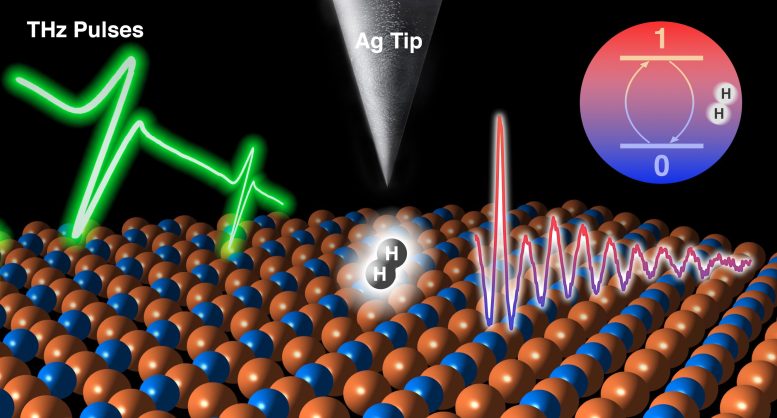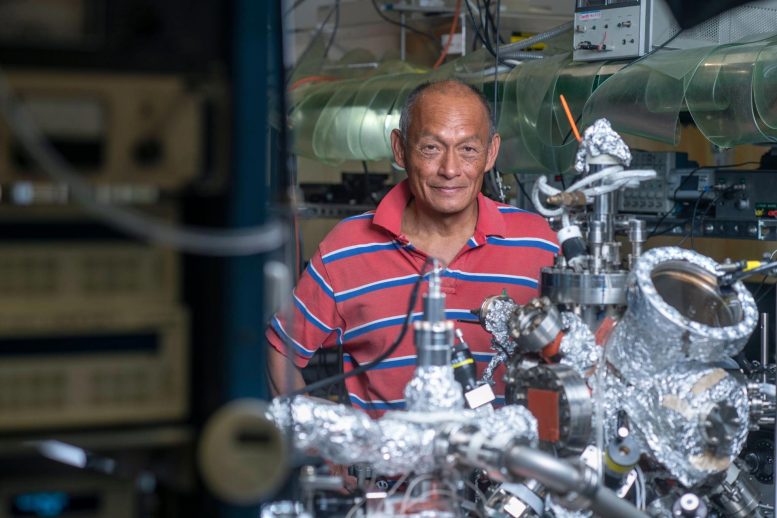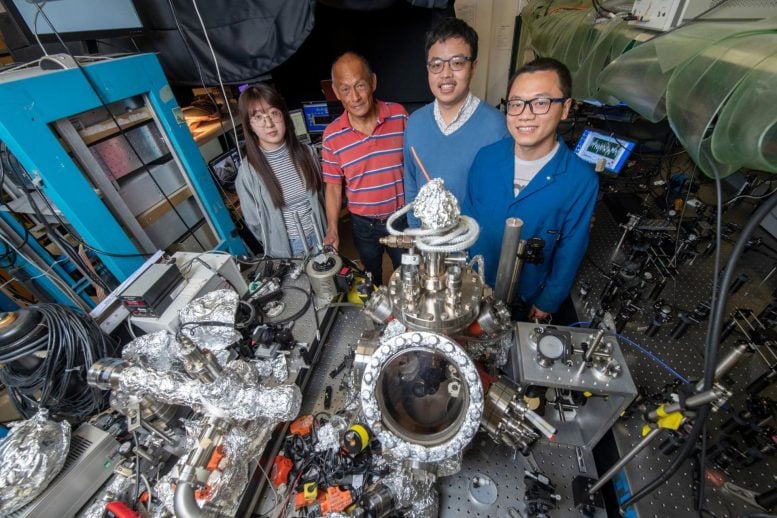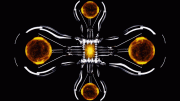
In the ultrahigh vacuum of a scanning tunneling microscope, a hydrogen molecule is held between the silver tip and sample. Femtosecond bursts of a terahertz laser excite the molecule, turning it into a quantum sensor. Credit: Wilson Ho Lab, UCI
New technique enables precise measurement of electrostatic properties of materials.
Physicists at the University of California, Irvine (UCI) have demonstrated the use of a hydrogen molecule as a quantum sensor in a terahertz laser-equipped scanning tunneling microscope, a technique that can measure the chemical properties of materials at unprecedented time and spatial resolutions.
This novel technique can also be applied to the analysis of two-dimensional materials which have the potential to play a role in advanced energy systems, electronics, and quantum computers.
On April 21, 2022, in the journal Science, the researchers in UCI’s Department of Physics & Astronomy and Department of Chemistry describe how they positioned two bound atoms of hydrogen in between the silver tip of the STM and a sample composed of a flat copper surface arrayed with small islands of copper nitride. With pulses of the laser lasting just trillionths of a second, the scientists were able to excite the hydrogen molecule and detect changes in its quantum states at cryogenic temperatures and in the ultrahigh vacuum environment of the instrument, rendering atomic-scale, time-lapsed images of the sample.

“This project represents an advance in both the measurement technique and the scientific question the approach allowed us to explore,” says co-author Wilson Ho, UCI Donald Bren professor of physics & astronomy. Credit: Steve Zylius / UCI
“This project represents an advance in both the measurement technique and the scientific question the approach allowed us to explore,” said co-author Wilson Ho, Donald Bren Professor of physics & astronomy and chemistry. “A quantum microscope that relies on probing the coherent superposition of states in a two-level system is much more sensitive than existing instruments that are not based on this quantum physics principle.”
Ho said the hydrogen molecule is an example of a two-level system because its orientation shifts between two positions, up and down and slightly horizontally tilted. Through a laser pulse, the scientists can coax the system to go from a ground state to an excited state in a cyclical fashion resulting in a superposition of the two states. The duration of the cyclic oscillations is vanishingly brief – lasting mere tens of picoseconds – but by measuring this “decoherence time” and the cyclic periods the scientists were able to see how the hydrogen molecule was interacting with its environment.

The UCI team responsible for the assembly and use of the terahertz laser-equipped scanning tunneling microscope pictured here are, from left to right, Dan Bai, UCI Ph.D. student in physics & astronomy; Wilson Ho, Bren Professor of physics & astronomy and chemistry; Yunpeng Xia, Ph.D. student in physics & astronomy; and Likun Wang and Ph.D. candidate in chemistry. Credit: Steve Zylius / UCI
“The hydrogen molecule became part of the quantum microscope in the sense that wherever the microscope scanned, the hydrogen was there in between the tip and the sample,” said Ho. “It makes for an extremely sensitive probe, allowing us to see variations down to 0.1 angstrom. At this resolution, we could see how the charge distributions change on the sample.”
The space between the STM tip and the sample is almost unimaginably small, about six angstroms or 0.6 nanometers. The STM that Ho and his team assembled is equipped to detect minute electrical current flowing in this space and produce spectroscopic readings proving the presence of the hydrogen molecule and sample elements. Ho said this experiment represents the first demonstration of a chemically sensitive spectroscopy based on terahertz-induced rectification current through a single molecule.
The ability to characterize materials at this level of detail based on hydrogen’s quantum coherence can be of great use in the science and engineering of catalysts, since their functioning often depends on surface imperfections at the scale of single atoms, according to Ho.
“As long as hydrogen can be adsorbed onto a material, in principle, you can use hydrogen as a sensor to characterize the material itself through observations of their electrostatic field distribution,” said study lead author Likun Wang, UCI graduate student in physics & astronomy.
Joining Ho and Wang on this project, which was supported by the U.S. Department of Energy Office of Basic Energy Sciences, was Yunpeng Xia, UCI graduate student in physics & astronomy.
Reference: “Atomic-scale quantum sensing based on the ultrafast coherence of an H2 molecule in an STM cavity” by Likun Wang, Yunpeng Xia and W. Ho, 21 April 2022, Science.
DOI: 10.1126/science.abn9220








Quantum proporties of molecules of all 92 natural elements have been verified to show average same value for space time.So,hydrogen molecule is a specimen to work as a perfect indicator or sensor throug implecation of this quantum property to check electromagnetic property of materials in 2-D.Again dipole moment of hydrogen molecule can produce a sharp timing spatial resolution.
Quantum properties of materials show quantum property equal to space time with fair average.So,hydrgen molecule is a good sensor to check electromagnetic property of materials in 2-D.Dipole moment of hydrogen molecule can give right time and spatial resolution.
I’m fascinated by these articles, but come away feeling like I know nothing about anything. Imagine getting your tinfoil out and making a quantum microscope? Another level. I can barely replace the mower belt on my John Deere.